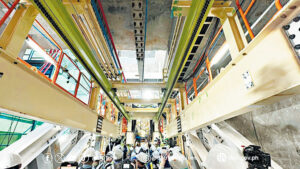Rail transit is one of the best ways to skip the grueling traffic on the road as it gives more convenience to commuters and can reduce their travel time within minutes. It serves as an efficient way to transport millions of passengers in the metro, helping them reach their destinations smoothly.
Travel by train, however, can often be challenged by crowded train cars, normalized long lines, and even glitches in the train, tracks, and systems. Acknowledging these apparent inconveniences, the Department of Transportation (DoTr) has been endeavoring to make the train commuting experience better for Filipino commuters.
As it celebrates its 126th anniversary this year, the DoTr shows its steadfast commitment to making railway transportation more efficient, effective, and secure, as shown by the progress of numerous projects.
Metro Manila Subway
The country’s first underground railway system, the Metro Manila Subway (MMS) Project seeks to revolutionize travel and help commuters avoid those pesky traffic jams.
The Metro Manila Subway spans 34 kilometers (km) and is considered the deepest subway in Southeast Asia with an average depth of 30 meters. Touted as the country’s “Crown Jewel” of mass transit system, the rail line is expected to reduce travel time between Valenzuela City to Ninoy Aquino International Airport (NAIA) in Parañaque City from 1 hour and 30 minutes to 35 minutes, as well as to carry 500,000 passengers a day. It will travel across eight cities, serving the eastern side of Metro Manila.
The DoTr, along with the Armed Forces of the Philippines (AFP), has launched the operations of the Tunnel Boring Machines (TBM), which are used to building tunnels underground. A total of 19 TBMs will be used to accelerate the construction of the underground rail system.
Currently, the Metro Manila Subway is at 18.24% progress and plans to push ahead this year. Given its significant progress, the subway is aiming for full operation in 2029.
North-South Commuter Railway
The 147-kilometer North-South Commuter Railway (NSCR) is set to offer a long-distance transport and connectivity across three regions in Luzon. With the capacity to serve 800,000 passengers, the project seeks to bring more access to high-quality passenger rail service, reducing lengthy travel time between North and South Luzon from four hours to two hours.
The NSCR will include 36 stations that will connect Manila to the North and South Luzon regions. The northern line will run 266 km from Manila to San Fernando, La Union. Its extension line goes from San Jose, Nueva Ecija to Cagayan, and a branch line is set to connect Tarlac and San Jose.
The southern line, meanwhile, is divided into the South Commuter Railway (Tutuban to Calamba) and the South Long-Haul (SLH) Project (Muntinlupa, Metro Manila to Matnog, Sorsogon). The SLH Project will cover 561 kilometers that will connect various cities, economic zones, and international ports.
The construction of the railway project is divided into three phases: Phase 1 (Tutuban, Manila, to Malolos, Bulacan), Phase 2 (Malolos, Bulacan to Clark, Pampanga), and PNR Calamba (Solis, Manila to Calamba, Laguna).
The Malolos-Manila and Clark Extensions are expected to finish this year. Additionally, the department is looking forward to having partial operations by the end of 2028, aiming for full completion in 2029.
Metro Rail Transit Lines 4 and 7
The Metro Rail Transit (MRT) Lines 4 and 7 are also building up the railway network in Mega Manila.
Connecting the bustling cities of the northeast Metro Manila, the 24-km MRT-7 consists of 14 stations and spans from North Avenue, Quezon City to San Jose Del Monte, Bulacan. This line aims to reduce travel time from around two to three hours to 35 minutes, and it is expected to serve 300,000 passengers per day and 800,000 passengers at most.
On the other hand, the 12.7-kilometer MRT-4 will feature 10 stations, connecting Ortigas Avenue alongside Epifanio de los Santos Avenue to Taytay, Rizal. This railway is projected to ease traffic congestion in the Eastern Metro Manila and will accommodate at least 400,000 passengers daily.
At present, MRT-7 is expected to open partial operations in late 2025, with full operations targeted between 2027 and 2028. MRT-4, meanwhile, is still at pre-construction stage and is yet to finalize project details, including engineering design and acquisition of land. The DoTr plans to start its construction by 2026.
Light Rail Transit Line 1 Extension
LRT-1 Cavite Extension — Photo from facebook.com/DOTrPH
The Light Rail Transit (LRT)-1 Cavite Extension is another railway project that is set to offer high-quality transportation to commuters in the metro. The extension will add another 11.7-kilometer railway line, featuring eight new stations connecting Pasay City to Bacoor, Cavite. This upgrade is Light Rail Manila Corp.’s (LRMC) commitment to providing world-class public transportation, making every commute experience more efficient and convenient. The LRT-1 extension is on track as it achieved 74% completion last year. It also started partial operations last November, opening up the Redemptorist, MIA, Asia World (PITX), Ninoy Aquino, and Dr. Santos (Sucat) stations. The new stations are expected to increase the estimated number of daily passengers from 320,000 to 400,000.
The entire extension, nonetheless, is anticipated to welcome additional 300,000 passengers in the LRT-1 line, expanding its total capacity of 800,000 passengers once fully operational in 2031.
“The LRT-1 extension is a significant Public-Private Partnership (PPP) project, which is expected to significantly improve connectivity to the south area of Metro Manila, easing traffic congestion and providing commuters with a faster and more convenient travel option,” LRMC said in a previous statement.
Unified Grand Central Station
Baliuag Fabrication Yard of the Metro Manila Subway Project, where the concrete walls being installed at the subway are manufactured and transported to the subway construction sites — Photo from facebook.com/DOTrPH
The Unified Grand Central Station in Quezon City, serving as a significant transportation hub in Metro Manila, will connect all major railway lines in Metro Manila: LRT-1 (located in west and south of Metro Manila), to MRT-3 (central part of Metro Manila), MRT-7 (north of Metro Manila), and the Metro Manila Subway (eastern part of Metro Manila).
With the construction of the Unified Grand Central Station, commuters can expect a big boost in connectivity, shorter travel times, reduced reliance on road transport, and an alleviation of traffic congestion in the metro.
As of 2024, the construction for the station has achieved 81%. — Angela Kiara S. Brillantes

